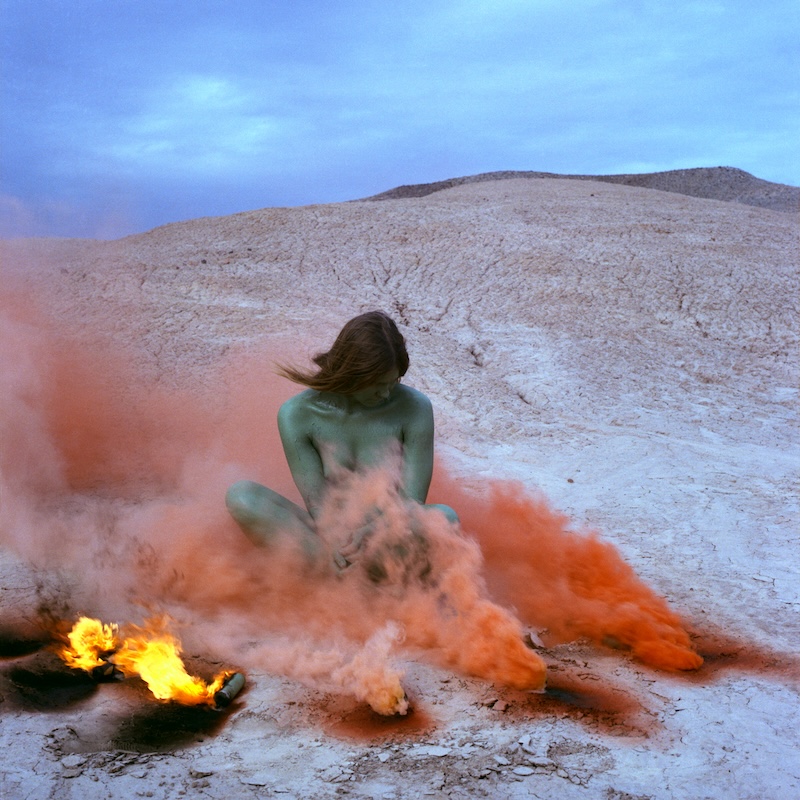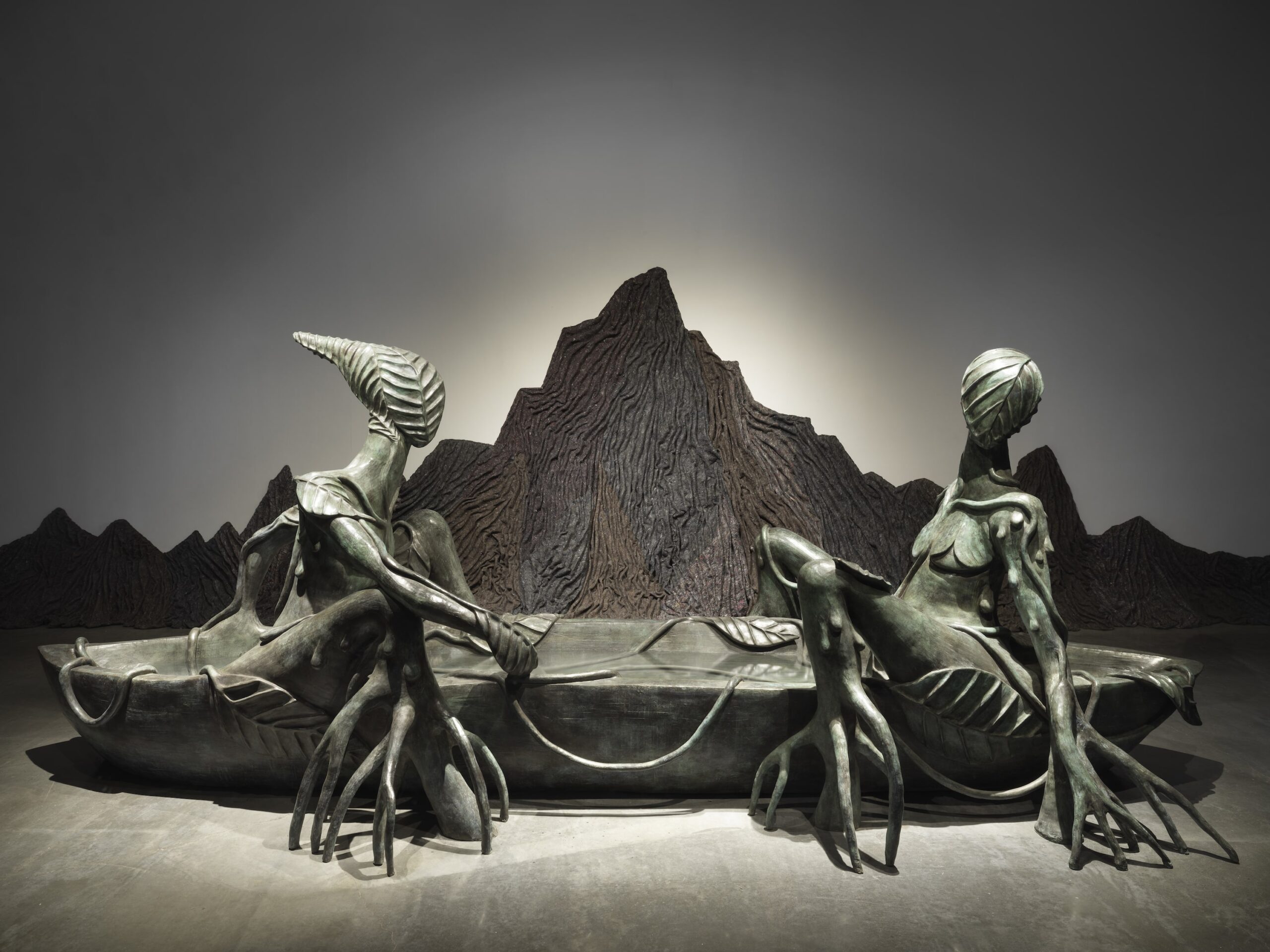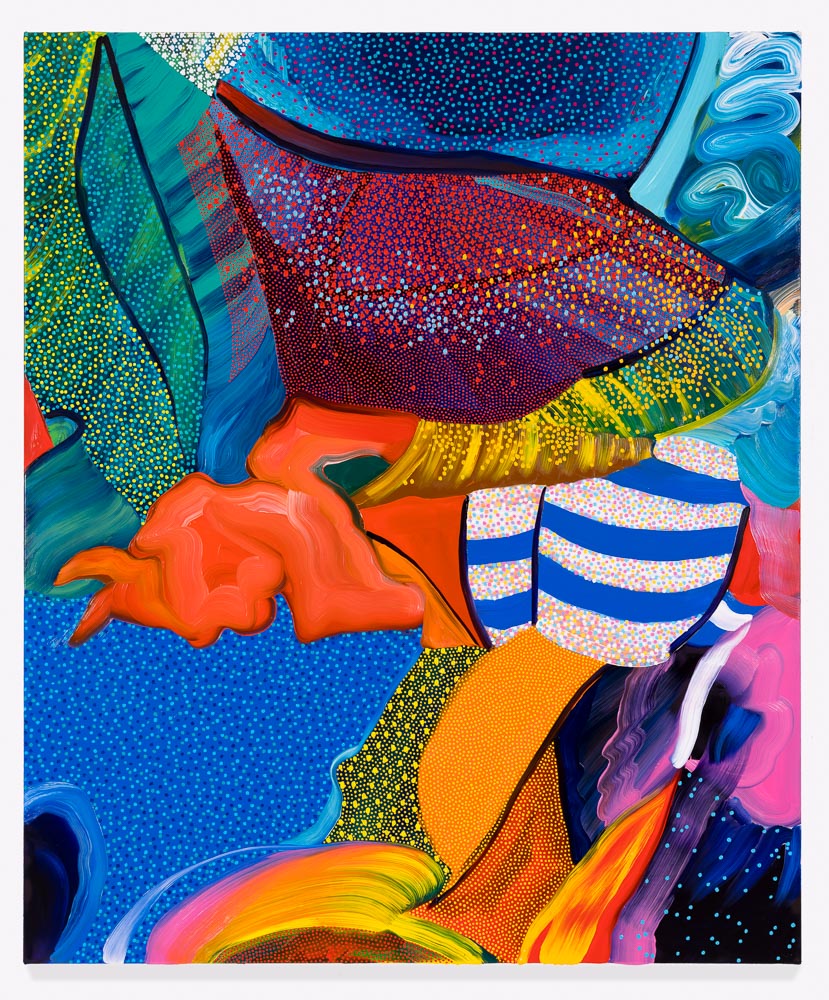On March 2 during The Armory Show, gallerist Anat Ebgi and Whitewall hosted an intimate evening featuring a conversation between artist Martin Basher and artist, critic, and curator Chris Wiley. That week, on view at the fair, was a presentation of new paintings and a site-specific installation by Basher at Anat Ebgi’s booth. Basher’s work has been exhibited at the Contemporary Art Galleries, University of Connecticut, Socrates Sculpture Park, and Grand Rapids Art Museum. Wiley is a contributing editor to Frieze and has worked on curatorial projects for The New Museum, Museum of Contemporary Canadian Art in Toronto, and the 8th Gwangju Biennial in 2010.
Below, we share a portion of that conversation, where Basher and Wiley discuss the new work, the beauty of painted light, and the dissertation Basher is currently writing on the history of the display of art.

Photo by Martin Cartegna
CHRIS WILEY: I wanted to start by talking about the tropical landscape theme that shows up a lot in this booth. When I saw it, I was struck by the resemblance to the generic travel posters that you would see in travel agencies. That kind of thing I remember from my childhood, where they’re seducing you into the idea of a tropical vacation, an escape from your normal life. And I was wondering, since we talked about this at a studio visit a couple of days ago, you both relate the tropics image to a sort of broader understanding of capitalist society, and also to your childhood. I was wondering if I could get you to talk about that a little bit?
MARTIN BASHER: It’s funny this has come up with this show. I’ve been making these paintings for a while. But I had a couple of studio visits a few weeks ago, and I was talking about my childhood. I grew up for a couple years in Fiji, and it was the first time that I’d actually threaded the dots and realized that I was making these Fiji paintings. I’d been so, so deeply in them without actually recognizing…

Photo by Martin Cartegna
CW: They just sort of like arose unconsciously.
MB: Very unconsciously, yeah. Yet the idea behind them was to find the most evacuated yet generic image of Eden, to find an image that could tap into the idea of escape and maybe a little bit of sublime too. What I’m drawing from when I’m making these paintings are those kind of posters that you might, as you say, see in like a travel agency or maybe the inspiring poster at the back of a…

Photo by Martin Cartegna
CW: In an office.
MB: Exactly. An uninspiring office space. I really wanted to get into the shorthand of the edenic, you know, like the experience of landscape might be, in those settings.

Photo by Martin Cartegna
CW: In the installation at The Armory, and also more generally in shows I’ve seen before, you also include a lot of consumer objects like mouthwash or booze juxtaposed with these generic landscapes. I feel like these can also key up that notion of the Edenic escape hatch. You were telling me at some point that this relates to another personal experience, from growing up and moving to the United States. How did that lay the groundwork for this work.
MB: Right. I moved here when I was 19. My parents came over for work, and I thought that I’d come over for a couple of months just to kind of like see, check out the scene. But, the story Mom and Dad told was that they were going to be moving to New York City. What actually transpired was they moved to Rockland County, which…

Photo by Martin Cartegna
CW: Is not New York City.
MB: …is most definitely not. If you haven’t been up there, it’s kind of like the exurbs outside of New York. There’s some very beautiful parts, but the big-box retail and strip malls stores have come through, and all the beautiful little towns are now not doing so great.

Photo by Martin Cartegna
CW: It’s like L.A. without the weather.
MB: Like L.A. without the weather, yeah. Or the beach. My sister was like about 16, and the two of us would just be like ‘oh my god, why did we move, what are we doing here?’ We just drove around in this rental car and just went up and down these big highways. And then eventually we found the Palisades Mall, which is like the second or third largest mall in America. And that was our entire cultural and social entry point into America!

Photo by Martin Cartegna
CW: That was your temple.
MB: Exactly! It was a temple, you know, and there really wasn’t a lot else going on in our life. We didn’t know anybody and we were just stuck out there, and it was really like we’d just say ‘what are we doing today?’ And we’d go to the mall again. And we’d find these amazing, beautiful things that American capitalism produces that you don’t get in New Zealand, because it’s small. There were three and a half million people in New Zealand when we left, in the whole country. There are more people in Brooklyn than there are in New Zealand. The scale of things in America was just mind-boggling. And we’d find things like these gallon-and-a-half single-serve bottles of Gatorade, you know, where it’s like [laughter] insane flavor and weird color and impossible size, it was just amazing. Its like here’s this thing that promises to make you an athlete but which would be more likely to give you diabetes and a heart attack.
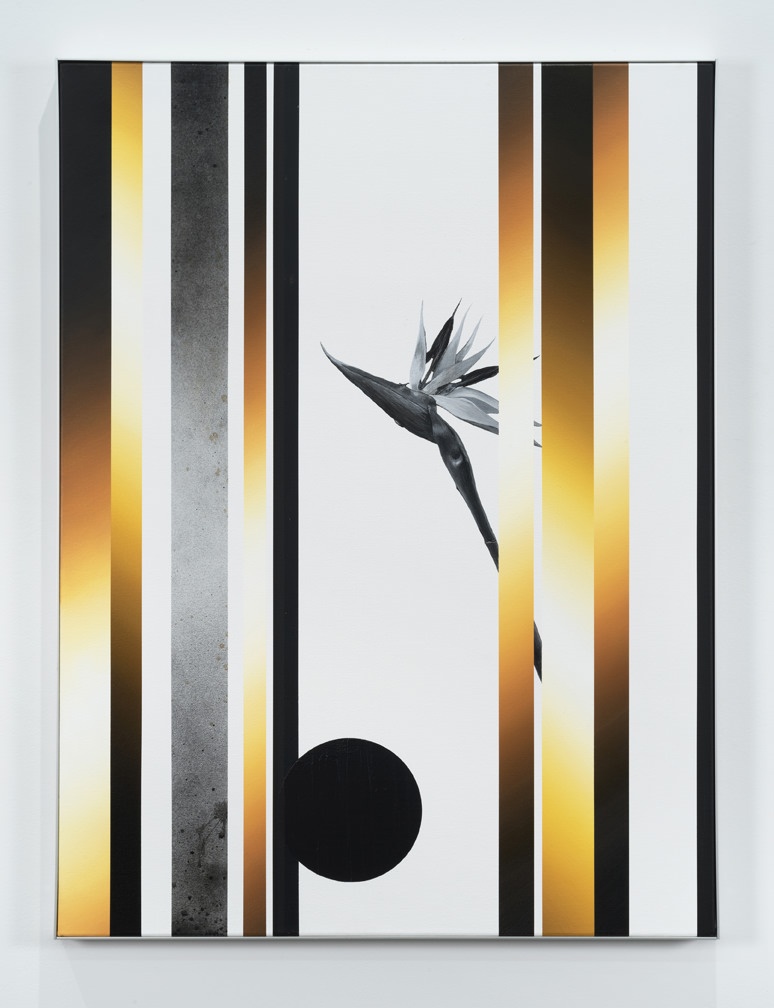
Martin Basher Untitled 2017, courtesy of Anat Ebgi
CW: You were interested in the odd artificial colors of products?
MB: Absolutely. And the scale and the volume. Incredible.
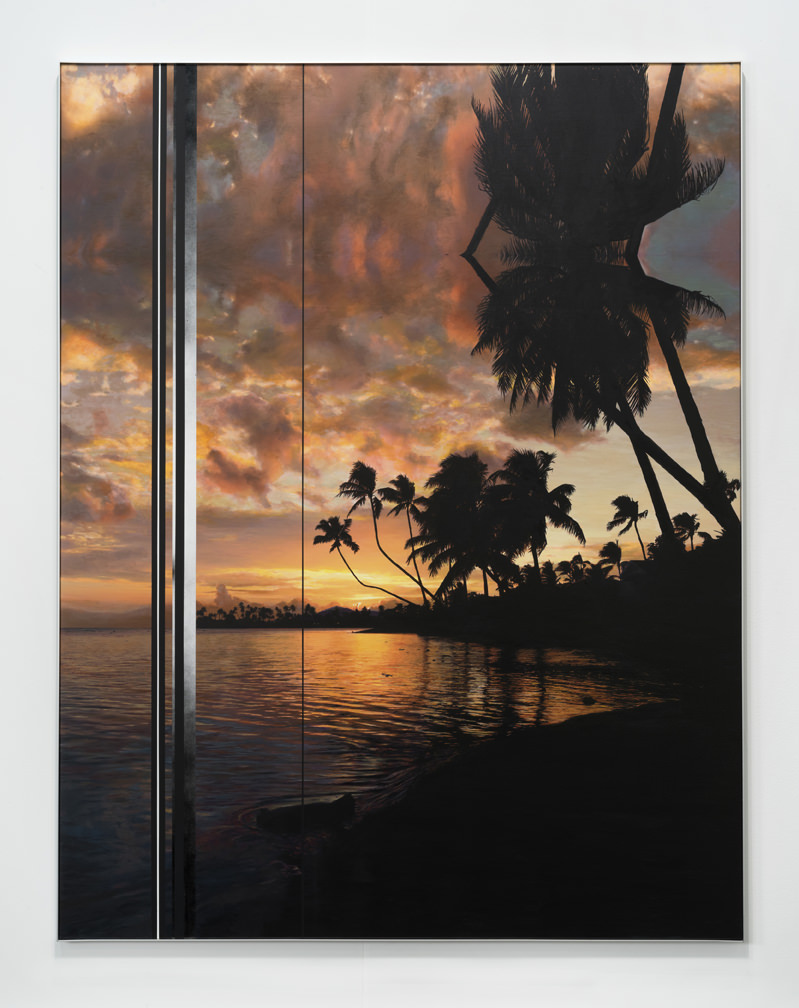
CW: And the products in your installations come from that?
MB: In a sense. I’m looking for objects with some of that promise. And also some of the perfection that’s conveyed or promised in the landscapes.
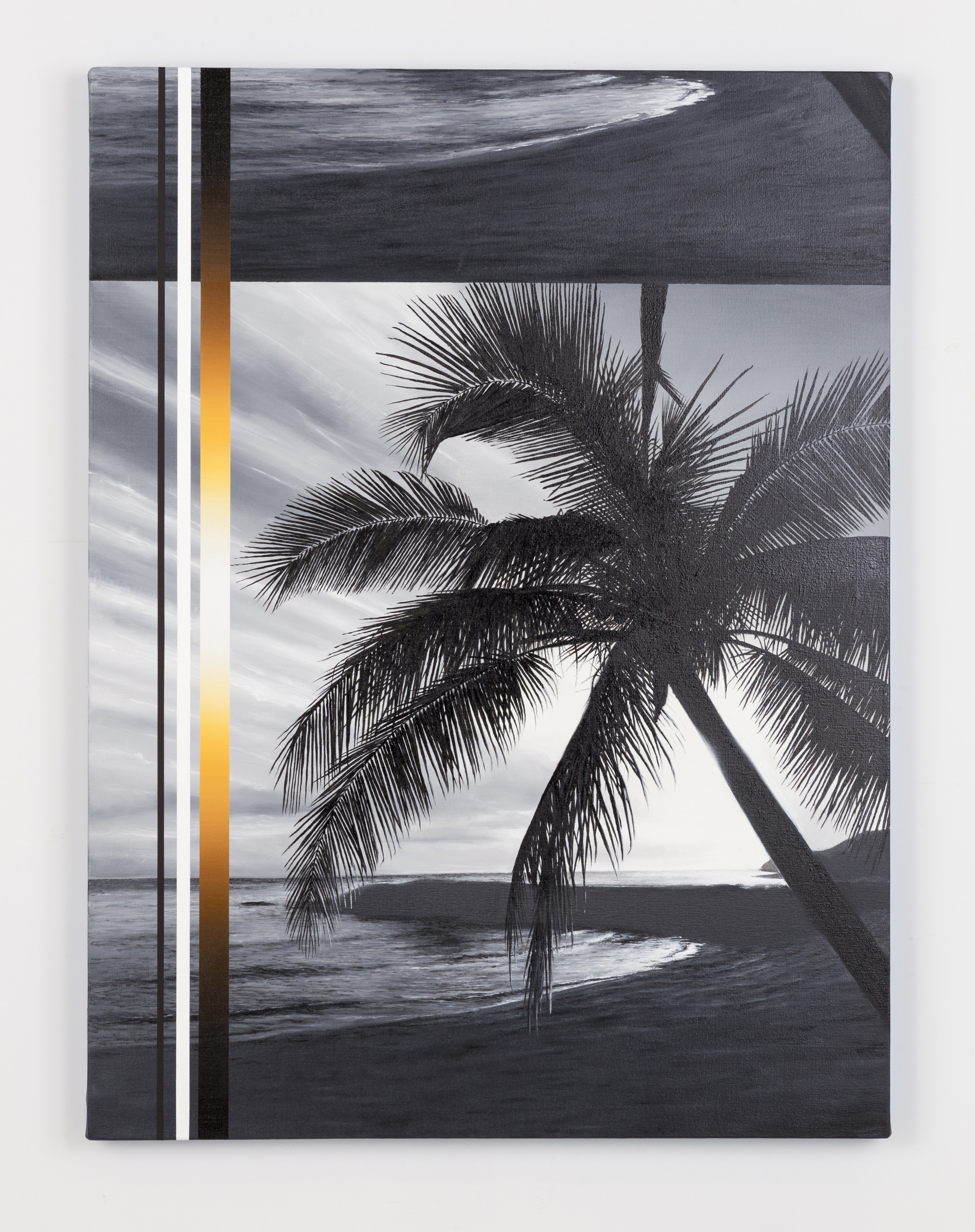
Martin Basher Untitled 2017, courtesy of Anat Ebgi
CW: It’s like you’ve created a landscape painting in an installation of consumer capital desire. I was thinking about this – I weirdly was watching a Club Med advertisement recently where they said something like “Club Med has made a contract with society” and you can get, you have your dreary life like all day, day in and day out, and then you get to go to paradise. That’s immediately what I thought of when I thought of this work.
But there’s also the minimalist painting aspect to your work, which also plays into the creation of that kind of atmospheric landscape. Is that partially your intention?
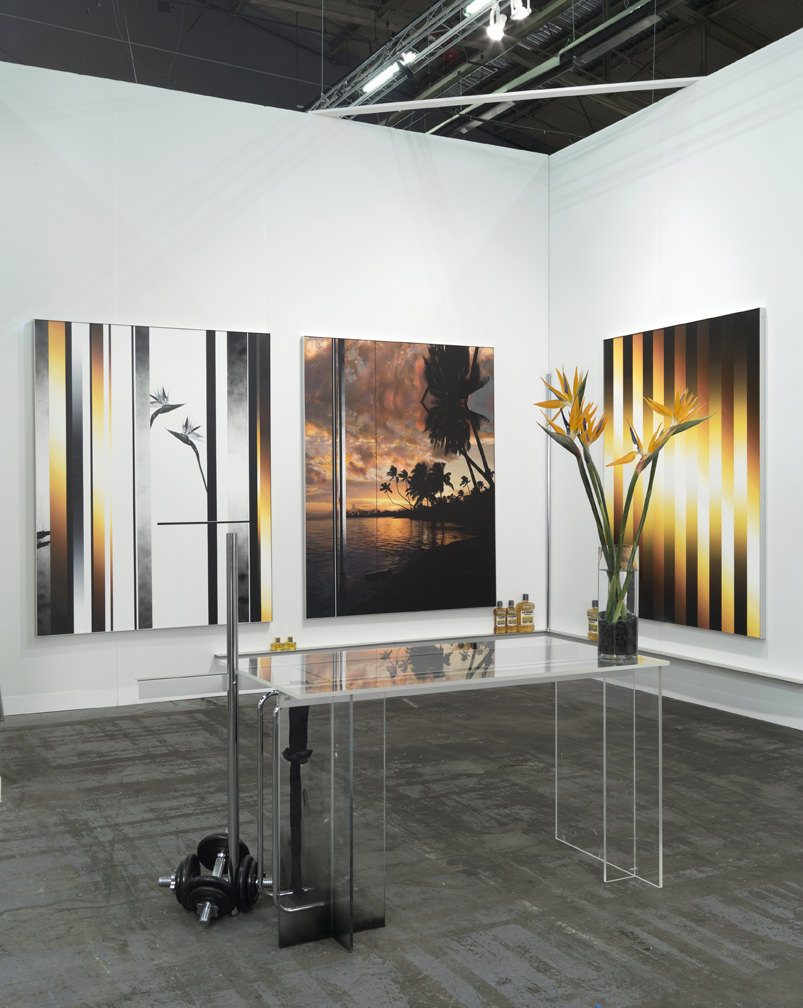
MB: Yes. When I started making this body of work the beach paintings were the anchor for the abstract paintings. I wanted to try working with the beach imagery in an abstract way, to see if I could derive some of the Photoshop perfection of the skies and the color, and the depth and the space, to just take the atmosphere and feeling of the beach images, and render it in some way that was abstract. It’s my hope that with the work that’s at the Armory that relationship is made quite clear – in the choice of color and the way that I’m trying to pull the spatial and light experiences out of the beach imagery and reproduce it in an abstract manner. To find the Starburst brilliance of a tropical sunset.
CW: I think this is a really key and interesting idea that you are exploring, in terms of how the way abstraction forms the entirety of your practice. The product is never going to be as good as it’s advertised. The vacation is never going to be as idyllic as the poster. Light is never going to be as beautiful as the light you paint.
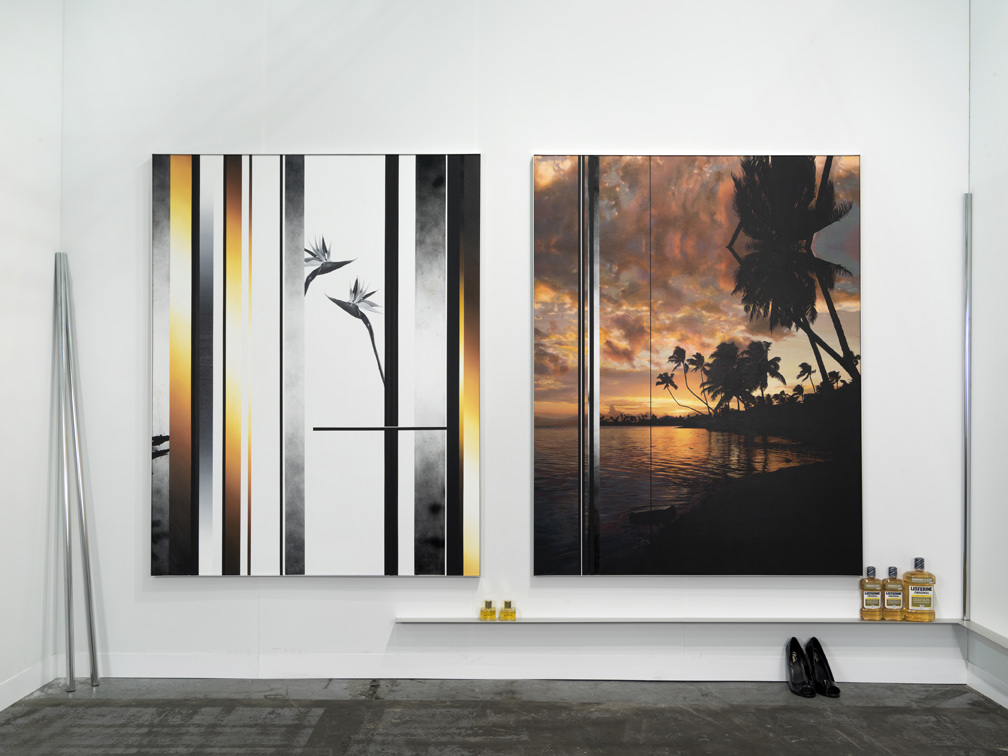
Martin Basher Untitled 2017, courtesy of Anat Ebgi
MB: Definitely. On this thread, I think of a couple of literary figures that I find really interesting, J.G. Ballard and Michel Houellebecq, a French writer. They both deal with this, an abstraction of tropical ideal and escape. But it’s artifice. A J.G. Ballard character or location is fleshed out in a single dimension, sketched so flatly its almost like they turn sideways and disappear. Everything is abstract, even the figurative bits. It’s a dreamscape, unreal.
CW: But also there are these interesting art historical resonances that give your work a depth. I thought immediately when I looked at the minimalist canvasses about the California Light and Space Movement from the 1960s and ‘70s. Is that something that you, you think about?
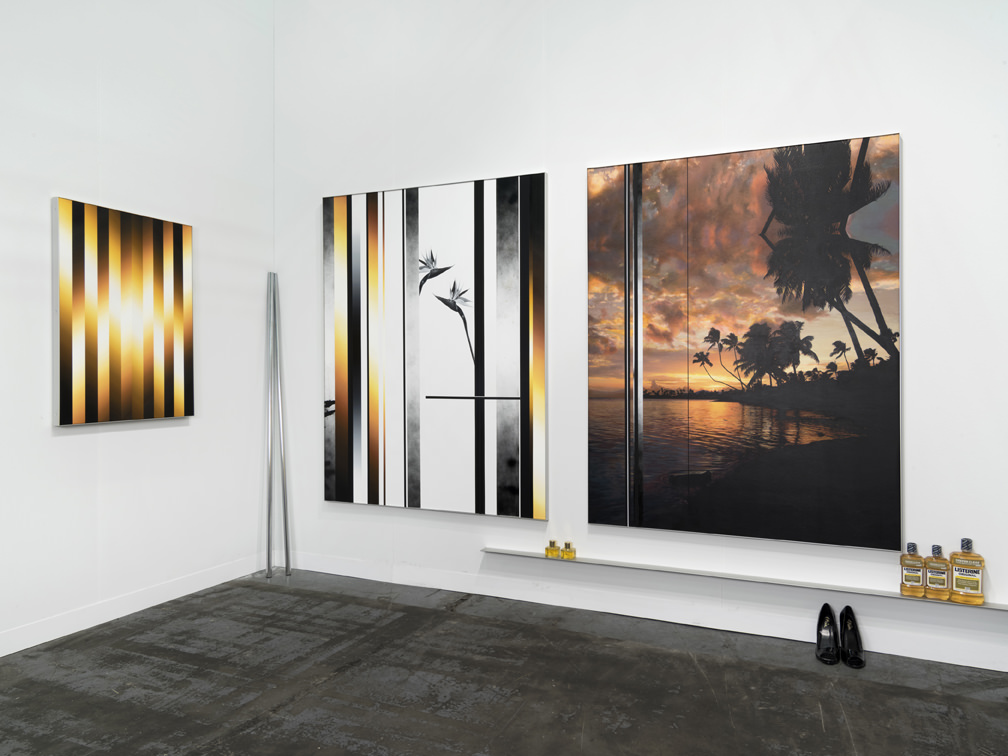
MB: Yeah, big time. Mary Corse and Larry Bell, and the amazing visual experiences within their work. That’s been a big consideration for me.
CW: Especially in the way that they were living on Venice Beach, Larry Bell and James Turrell and these people we associate with that, that movement. They were interested in the light of the beach, and the slick surfaces of cars, and all of these things that are about American-ness, America seen through the lens of a Beach Boys song or something. Unlike say Donald Judd or Dan Flavin, who were dealing with kind of like cold, hard, industrial facts, really interested in materials as such.
MB: That’s true. Though since you mention Judd and Flavin, one thing that I’ve been thinking about a lot, something that informs the way that I make my objects a lot came to me beautifully while visiting Judd’s house—over on, is it Green or Spring St?
CW: Spring.
MB: Spring. When thinking about how those guys were working, and this is like both coasts, you know, so we are talking Light and Space, too, there’s just a plethora of new materials available at that time. For instance Soho was a commercial district. So they were working right down the street from the fluorescent light store and the aluminum supply store on Canal, right? Maybe a car-painter in Venice. They used what was in front of them. And there’s a beautiful kind of logic, you can see in it, its really visible in the spaces that Judd made as his personal living spaces as. The work is born of commercially existing materials, with the expedience and the logic that comes with industrial standardized sizes and forms. The way that those things can be rendered very quickly and into very beautiful, very unambiguous, seductive objects.
CW: You’re writing a dissertation now on the history of display in art. I was wondering if you could give us a little bit of a sense of how you think about that history and how you maybe contextualize your own work within it. So just like some key figures that you were thinking about.
MB: Right, so I’m writing this paper. I’ve been at this thing for four years and I have to deliver it in a month, so I’m cranking here.
CW: You’re going to leave here and just go to your laptop.
MB: Yeah, I gotta go to my laptop. But the line of inquiry, in what I’m writing, is to look at display aesthetics and the ways that artists have engaged with these, particularly in New York in the last 20-30 years. As a, jumping-off point, the early work of Jeff Koons and Haim Steinbach are the touchstone, talking here in particular about the vitrines with the vacuum cleaners that Jeff Koons produced in the early ‘80s, and Steinbach’s shelf works. Those have been something of a touchstone for my practice – logically since I employ a lot of consumer goods in the work that I’m making. If the minimalists and light and space artists circled display with their material choices, this work jumps right into display’s bed.
CW: Sure.
MB: One of the things that I’ve found very interesting about Steinbach’s practice is that he’s repeatedly made a case for the autonomy of objects when they are put on a shelf. It’s almost a like sense of curation that happens, you put a couple of idiosyncratic, weird things together and they start to speak to each other and create tensions in the ways that they, and their meanings collide.
CW: …and presumably they start to speak for themselves in a way that they wouldn’t on a shelf in a store, for instance.
MB: Yes, absolutely. Though that’s maybe because the display logic in a retail setting is predictable. Steinbach’s isn’t. But I think for the way that I’m trying to deal with that in my practice, I don’t want the objects to be just simply speaking their own internal logic. I’m trying to select things which speak to the sense of utopian, sublime space we have been talking about, which in some way convey the fraught grace and desire and aspiration in the beach paintings. I try to find objects that that in some way might take us from very work-a-day and very banal places to something spiritual and exalted. Talking about desire and consuming, maybe what we’re chasing in these objects are little dopamine flashes, feelings that have a relationship to something almost spiritual as well.
CW: That seems like you just described the kernel or the center of the atmosphere that you’re trying to create with.
MB: Absolutely. That’s my hope, yes. Longing, and desire, and beauty and the way that those things are both present, but fleeting, and kind of resistant as well. In the art object and the consumer object. Because in essence, they are all the same.
CW: Where it’s like you get beyond the critical stance, you know, past “Oh, consumerism does seduce us in ways that are potentially bad,” and behind that maybe there is something like essential and human.
MB: There’s a sense of that. Grace.





